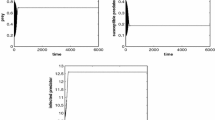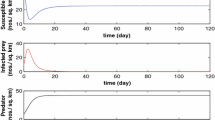Abstract
This paper focuses on the study of a mathematical predator-prey epidemic model supplying alternative food to predator. The main objective is to study the consequences of providing alternative food on the epidemic system. Different basic reproduction numbers are determined and the impacts of alternative food in reducing infected individuals are discussed. The dynamical behaviour of the system is investigated from the point of view of stability and persistence both analytically and numerically. To achieve the control of disease, an optimal control problem is formulated and solved. Numerical results illustrate that there exists a critical infection rate above which disease free system can not be reached in absence of alternative food, but suitable alternative food leads the system disease free with higher infection rate. The disease free system will be also obtained in presence of seasonally varying contact rate. This study is aimed to introduce a new non-chemical method for controlling disease in a predator-prey system.








Similar content being viewed by others
References
Kermack WO, McKendrick AG (1927) A contributions to the mathematical theory of epidemics. Proc R Soc Edinb Sect A Math 115:700–721
Kermack WO, McKendrick AG (1932) Contributions to the mathematical theory of epidemics, ii—the problem of endemicity. Proc R Soc Edinb Sect A Math 138:55–83
Kermack WO, McKendrick AG (1933) Contributions to the mathematical theory of epidemics, iii—further studies of the problem of endemicity. Proc R Soc Edinb Sect A Math 141:94–122
Anderson RM, May RM (1986) The invasion, persistence and spread of infectious diseases within animal and plant communities. Philos Trans R Soc Lond B 314:533–570
Hadeler KP, Freedman HI (1989) Predator-prey populations with parasite infection. J Math Biol 27:609–631
Haque M, Chattopadhyay J (2007) Role of transmissible disease in an infected prey-dependent predator-prey system. Math Comput Model Dyn Syst 13:163–178
Haque M, Venturino E (2006) The role of transmissible diseases in the Holling–Tanner predator-prey model. Theor Popul Biol 70:273–288
Haque M, Venturino E (2007) An ecoepidemiological model with disease in predator: the ratio-dependent case. Math Methods Appl Sci 30:1791–1809
Haque M, Greenhalgh D (2010) When a predator avoids infected prey: a model-based theoretical study. Math Med Biol 27:75–94
Sahoo B, Poria S (2013) Disease control in a food chain model supplying alternative food. Appl Math Model 37:5653–5663
London WP, Yorke JA (1973) Recurrent outbreaks of measles, chickenpox and mumps. 1. Seasonal variation in contact rates. Am J Epidemiol 98:453–468
Yorke JA, Nathanson N, Pianigiani G, Martin J (1979) Seasonality and the requirements for perpetuation and eradication of viruses in populations. Am J Epidemiol 109:103–123
Buonomo B (2011) On the optimal vaccination strategies for horizontally and vertically transmitted infectious diseases. J Biol Syst 19:263–279
Das KP, Chatterjee S, Chattopadhyay J (2009) Disease in prey population and body size of intermediate predator reduce the prevalence of chaos-conclusion drawn from Hastings–Powell model. Ecol Complex 6:363–374
van Rijn PCJ, van Houten YM, Sabelis MW (2002) How plants benefit from providing food to predators even when it is also edible to herbivores. Ecology 83:2664–2679
Srinivasua PDN, Prasada BSRV, Venkatesulub M (2007) Biological control through provision of additional food to predators: a theoretical study. Theor Popul Biol 72:111–120
Srinivasu PDN, Prasad BSRV (2010) Role of quantity of additional food to predators as a control in predator-prey systems with relevance to pest management and biological conservation. Bull Math Biol. doi:10.1007/s11538-010-9601-9
Haque M (2011) A detailed study of the Beddington–DeAngelis predator-prey model. Math Biosci 234:1–16
Haque M (2009) Ratio-dependent predator-prey models of interacting populations. Bull Math Biol 71:430–452
Hsu SB, Huang TW (1995) Global stability for a class of predator-prey systems. SIAM J Appl Math 55:763–783
Freedman HI, Waltman P (1984) Persistence in models of three interacting predator-prey populations. Math Biosci 68:213–231
Kumar R, Freedman H (1989) A mathematical model of facultative mutualism with populations interacting in a food chain. Math Biosci 97:235–261
Butler GJ, Freedman H, Walteman P (1986) Uniformly persistent systems. Proc Am Math Soc 96:425–429
Pontryagin LS, Boltyanskii VG, Gamkrelidze RV, Mishchenko EF (1962) The mathematical theory of optimal processes. Wiley, New York
Clark CW (1990) Mathematical bioeconomics: the optimal management of renewable resources. Wiley, New York
Lenhart S, Workman JT (2007) Optimal control applied to biological models. Mathematical and computational biology series. Chapman & Hall/CRC, Boca Raton
Joshi HR (2002) Optimal control of an HIV immunology model. Optim Control Appl Methods 23:199–213
Birkoff G, Rota GC (1982) Ordinary differential equations. Ginn, Boston
Zaman G, Kang YH, Jung IH (2008) Stability analysis and optimal vaccination of an SIR epidemic model. Biosystems 93:240–249
Taylor N, Walters C (2010) Estimation of bioenergetics parameters for a stunted northern Pikeminnow population of south central British Columbia. Open Fish Sci J 3:110–121
Steele JH, Henderson EW (1992) The role of predation in plankton models. J Plankton Res 14:157–172
Hastings A, Powell T (1991) Chaos in a three-species food chain. Ecology 72:896–903
Butzel HM, Bolten AB (1968) The relationship of the nutritive state of the prey organism Paramecium aurelia to the growth and encystment of Didinium nasutum. J Protozool 15:256–258
Cheney DL et al (2004) Factors affecting reproduction and mortality among baboons in the Okavango Delta, Botswana. Int J Primatol 25:401–428
Stone L, Olinky R, Huppert A (2007) Seasonal dynamics of recurrent epidemics. Nature 446:533–536
Author information
Authors and Affiliations
Corresponding author
Rights and permissions
About this article
Cite this article
Sahoo, B. Disease control through provision of alternative food to predator: a model based study. Int. J. Dynam. Control 4, 239–253 (2016). https://doi.org/10.1007/s40435-014-0099-0
Received:
Revised:
Accepted:
Published:
Issue Date:
DOI: https://doi.org/10.1007/s40435-014-0099-0




